Most people are familiar with gold white и yellowBut this is by no means a complete list of varieties of the precious metal. Among them, there are rarer ones, such as the blue alloy colors. Jewelry made of such material is in demand despite the fact that their price tens and sometimes hundreds of times higher than the average market value of this category of products. This is explained by the difficulties associated with manufacturing alloy.
It is still unknown exactly how the blue gold was previously obtained.
Several methods have been unraveled and are used today. However, in order to preserve the original properties, it is necessary to ensure proper care of the products.
What is blue gold
Blue, blue gold are similar metals, but they differ in the intensity of the hue, which is due to the difference between the compositions. Alloys can be obtained by various methods, but not all of the finished materials are characterized by suitable performance parameters. In addition, even the blue color sometimes does not correspond to the color coordinates of CIELAB, the metal so conventionally. In fact, the precious metal obtained using one of the techniques is characterized by a grayish hue. When the composition is changed, it takes on a bluish tone. These materials belong to the group of intermetallides.
These are alloys obtained by chemical reactions in the interaction of different components.
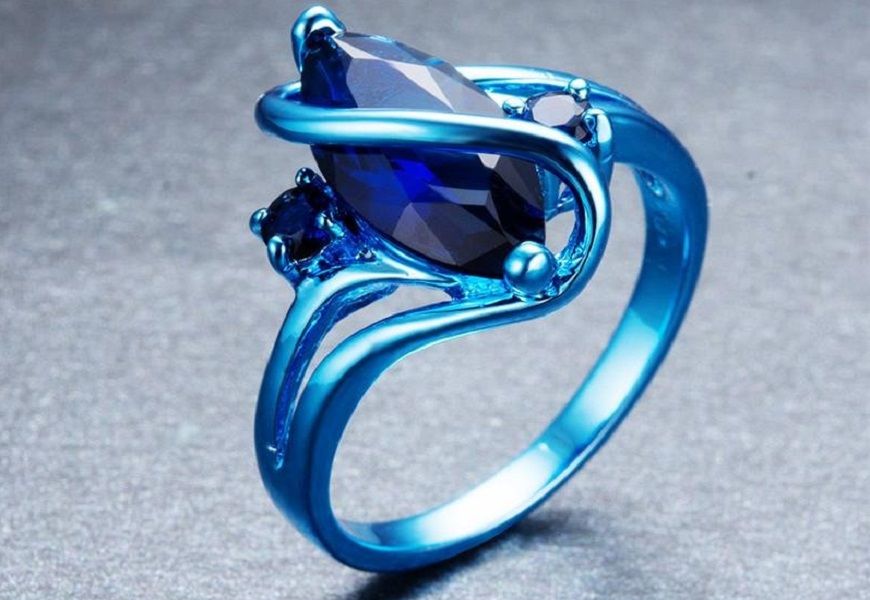
The History of the Discovery of Scythian Gold. Recipes of the ancient alchemists. Antoniassi's Secret Technology
Blue gold is a mystery that has not yet been solved. The alloy has been in use for a long time; the first products are several thousand years old. It is believed that the Scythians were the first to produce blue gold.
Some items have survived to the present day, but they are of high value and therefore cannot be taken for analyses to determine the component composition and to clarify the technology of production of the precious metal. At the same time, evidence has been found that a method based on combining the gold and iron in a ratio of 3:1.
Even later (in the 17th century), the Argentine goldsmith Antoniassi developed a technology that made it possible to obtain a true heavenly color and a high purity (985) precious metal.
He kept the secret of creating the material secret, but international rules require that a list of components be provided, so the composition was revealed. It turned out that this was not enough to recreate the precious metal with a heavenly hue; it was necessary to know the technology of the process. Some jewelers figured it out on their own.

Composition, shades and grades of blue and blue gold
Today you can buy jewelry made of a rare alloy, which includes components: gold itself, steel, platinum, iridium. Their ratio, respectively: 75%, 22%, 2.5% and 0.5%. This version of the celestial-colored precious metal is the most common today. In comparison, the Argentinian Antoniassi previously used a method based on 90% gold, to which a small amount of cadmium was added, among other things. Nowadays, other intermetallides (alloys chemically obtained on the basis of 2 or more metals) are also used:
- 585 and 750, for which pure gold and iron are used in the ratio: 2:1 and 3:1, to improve the properties of the composition is introduced chromium and other ligatures;
- indium-based alloy: it allows the precious metal to have a grayish, bluish and even deep blue hue (depending on the composition), the ratio of components: 46.2% gold, 53.8% indium, resulting in a rather low assay of 462;
- Gallium-based - the metal takes on a pale blue tone (ratio of components: 56% gold, 44% gallium).
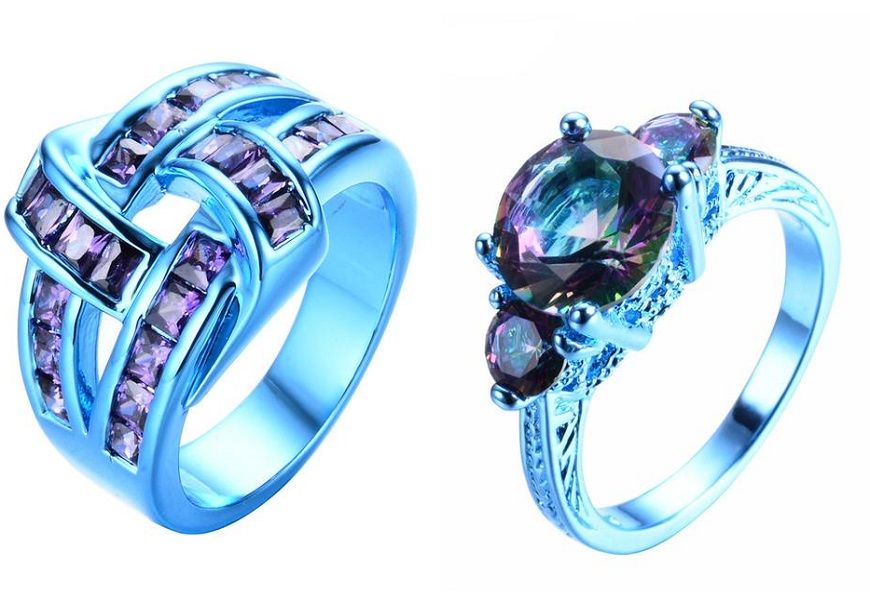
Physical properties of exotic gold chemical alloys
The main characteristics of the precious metal of the heavenly color:
- low strength, which determines the durability of products - they are easily damaged, wear out quickly (there are signs of exploitation);
- low plasticity;
- magnetic properties depend on the steel content, not all production technology of the precious metal characterized by celestial tint, suggest the need for such a component;
- brittleness - the metal cannot withstand pitting.
Important: Not all types of jewelry are characterized by the same properties, which is due to the difference between the compositions: some items of deep blue color crumble, deformed at the slightest pressure, others are more resistant to mechanical stress (most often so behave those that contain iron).
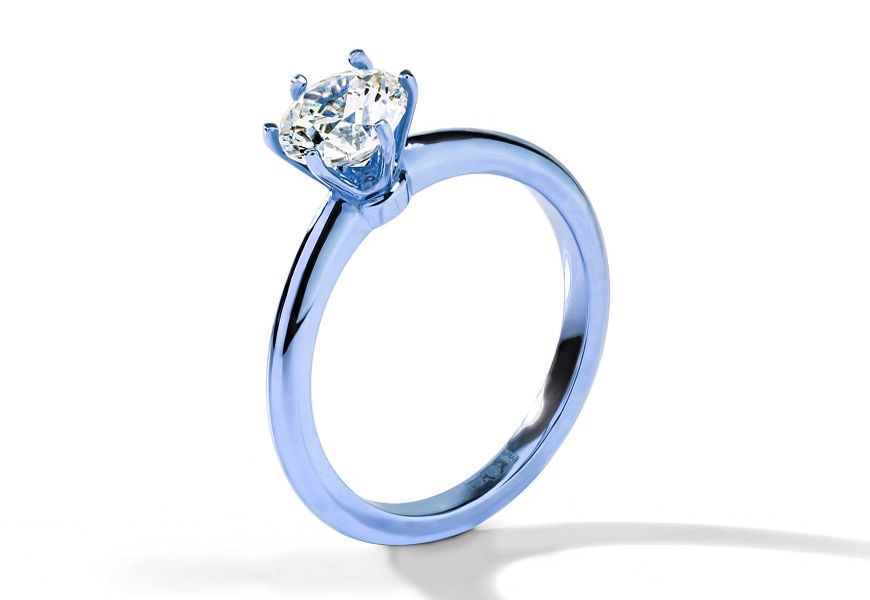
Secret modern technology for producing sky-blue gold
There are several technologies for producing blue alloy. They involve combining components and protecting the finished products with a special coating. Different manufacturers use their own secrets to obtain blue gold. And the exact formula is hidden. Despite the established international rule established by the Association of Jewelers, not all disclose the technology of production, not to mention the composition of the material.
Chemical alloys
In the production of jewelry made of blue precious metal different techniques are used: alloying with iron, chemical reactions with other metals. The intermetallics are a compound of gold and gallium or indium. The latter components are fusible, and enhance the properties of the material. The result is blue gold, which has better characteristics than the pure metal.
Such production technologies have the advantage that the product acquires the desired hue throughout its thickness.
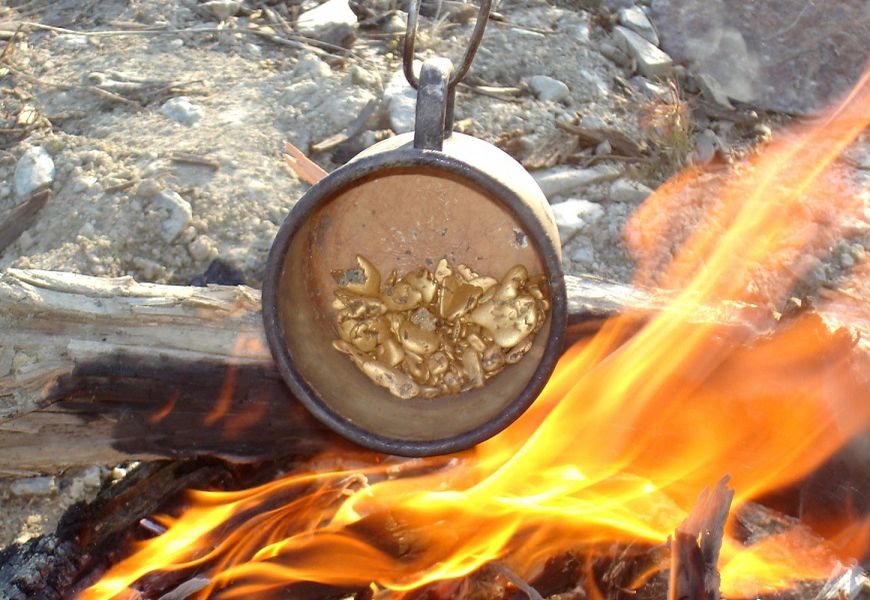
Rhodium plating
To give the decoration a noble color, a heavenly hue, use different methods of coating:
- application of a special varnish;
- rhodium applications.
The presence of a coating improves the properties of the product, with the precious metal of a heavenly hue retaining its attractiveness longer. However, the surface layer itself is not durable and deforms.
This means that jewelry made with this technology is less durable and has less value.
Narrow use of blue gold in the jewelry industry
Considering that sky-colored metal is not strong, prone to pitting, unplastic and has no tendency to stretch, its field of application is narrow. Such material is mainly used for the production of decorative inserts for jewelry, less frequently it is used in the production of solid objects. The bluish-colored precious metal inlays can be found in certain kinds of items:
- cases, wristwatch bracelets;
- set items.
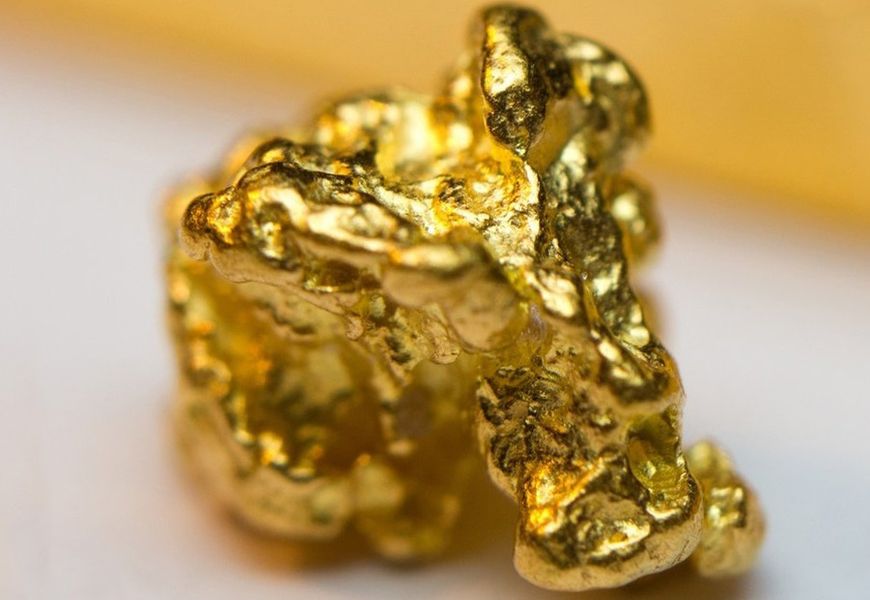
The best alloy
Metals based on indium, gallium are not of high quality, because they contain a large number of additives. This makes it possible to get a material of low samples. The other technology of making a bluish-tinted precious metal (on the basis of steel) is also not ideal. The shade was given a conditional name, as it is close to gray. So far, the component-based version is the best in terms of quality:
- 750 parts gold;
- 25 - platinum;
- 220 - steel;
- 5 - iridium.
How to choose an original
Not every piece of blue jewelry contains gold. To verify whether a ring or chain is a jewel, you must take into account the criteria:
- Assay and manufacturer's mark: an item that contains a precious metal is always marked with a notation that determines the value of the alloy used in the manufacture (assay), most often there is also the manufacturer's mark;
- For comparison, yellow gold does not show these characteristics, but the composition of the blue alloy can include iron, which moves the jewelry in the category of lower quality, and also products of this type exhibit magnetic properties, there are also varieties of blue precious metal based on gallium, indium, in their composition does not include steel;
- proven brand, famous salon: large stores have gained popularity due to trading in certified high quality goods, when buying, you should choose well-known retail chains that have been on the market for a long time;
- electronic detector - one of the expensive ways, such a device is not available everywhere, but thanks to the detector you can determine the electrical conductivity of the metal, which will know its composition;
- shopping accompanied by a jeweler: you need to invite a proven specialist, but his services are an additional item of expenditure, as a result, the total cost of the jewelry will be more expensive.
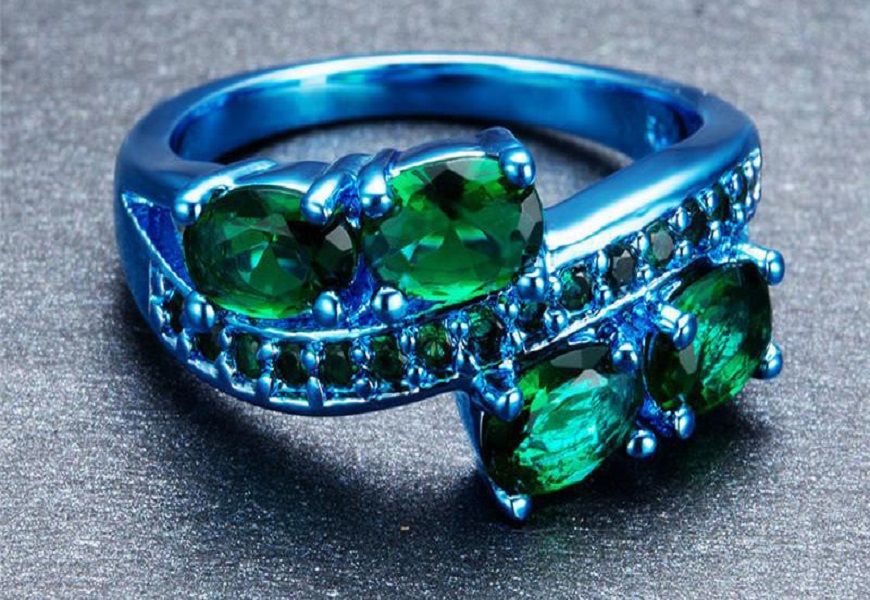
Important: do not check the jewelry with folk methods (using vinegar, iodine, etc.), because they do not guarantee the exact result, can spoil the product, in addition, often improvised means give a false impression of the properties of jewelry (when applied material does not lose the properties as well as gold, but it does not contain the precious metal).
How and with what to wear blue gold
Blue inlays in jewelry are most often combined with pink, in red, yellow and white gold. They go well with gemstones as well. If jewelry made of such metal is matched with certain clothes, you can consider the options:
- accentuate the image in blue or blue shades;
- use contrasting materials: light-colored clothing and jewelry in rich blue.
In addition, metal of this shade goes well with gold things in the closet. You can also use other accessories of blue, blue color.
How to care for brittle metal
Key recommendations:
- Blue gold is easily damaged, so this type of jewelry should not be worn daily;
- The items should be wiped from time to time with a rag soaked in a soapy solution;
- Choose a jewelry box with a soft coating inside for storage, but it is important to keep the blue precious metal jewelry separate from the rest.
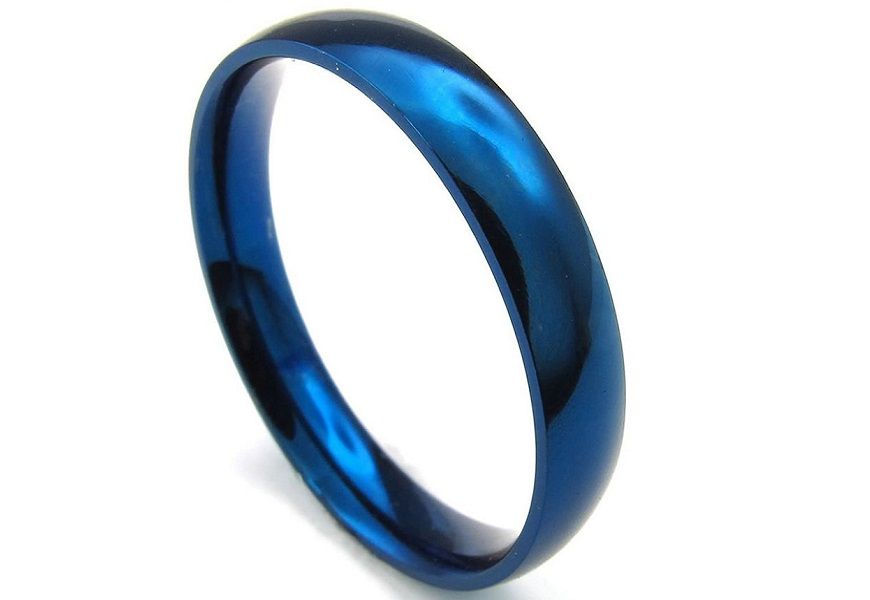
Where you can buy and how to sell blue precious jewelry. The cost of 1 gram of blue gold
It is not possible to buy products in a heavenly shade everywhere. The likelihood of finding them in the assortment of large retail chains is much higher than in small stores. It is difficult to sell such products, because their cost is high. You can consider options:
- pawn shop;
- sale to the store in order to buy a new product.
The cost of jewelry of different compositions significantly different. If we consider blue gold, the price per gram today is 10,000 rubles.
Video: blue gold in the jewelry industry
Reviews
My husband gave me a bracelet with blue gold inlays. To be honest, for a long time I thought it was the colored blue metal (no one showed me the receipt, of course). Recently I've learned that this blue gold price per gram of 585 struck me - more than 9000 rubles. After that I looked at my husband in a different way, it turned out that he, though silent, but appreciates me.


When I worked for a foreign company, I could afford a vacation in the Maldives four times a year, worthwhile jewelry. There was even a blue gold ring. But it is not so good to wear, it scratches quickly. I wore it only on special occasions.
Once an unpleasant situation happened with blue gold: my ex-boyfriend gave me a jewelry piece as a present, he presented it with pathos. Later, when we had already broken up, I decided to sell it, it turned out to be a simple jewelry with a blue tone coating. The price, of course, is different for such a product - much lower.

Jeweler's comment

